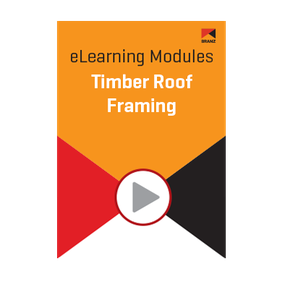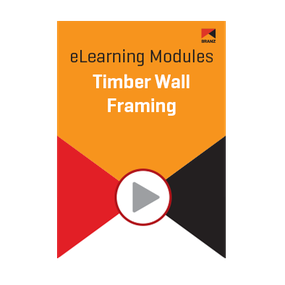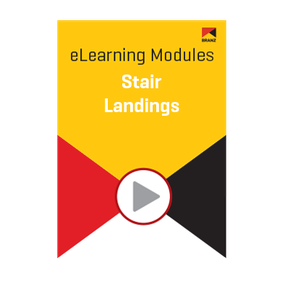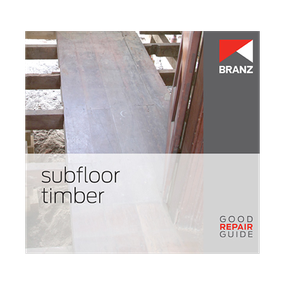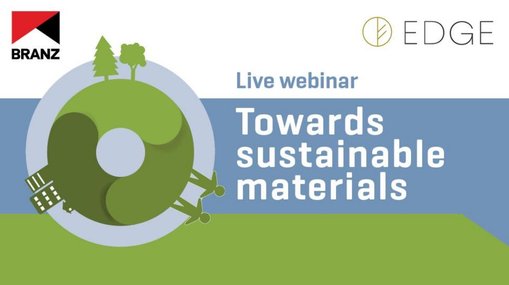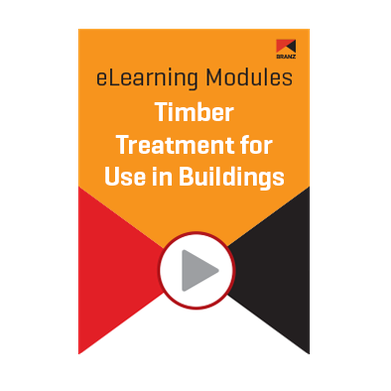
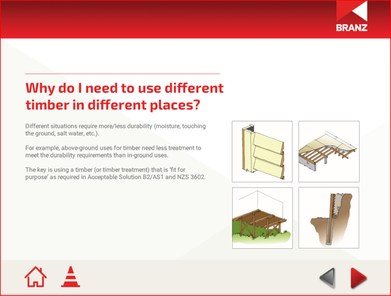
Module: Timber treatment for use in buildings
Product Description
This module focuses on the basic concepts of timber treatment for use in buildings.
Topics covered in this self-paced module:
- Why do I need to use different timber in different places?
- When can I use different timber?
- How do I know what it has been treated with?
- What fixing can I use with which treatment?
- What are common mistakes/problems with treated timber?
- Library of useful materials
Gain 100% in the test at the end of the module, and you\'ll receive a record of your completion that can be submitted as part of your CPD activity log.
| Publication date | 1 June 2020 |
|---|---|
| Product type | eLearning module |
| Availability | Available |
| Product code | EL028 |
Recommended items
Module: Timber roof framing
This module focuses on the concepts and features critical to the design of timber roof framing.
Topics covered in this self-paced module:
- What types of framed roof construction are there?
- What factors affect roof framing construction?
- How does roof framing resist loads?
- Library of useful material
- Did I understand all of this?
Gain 100% in the test at the end of the module, and you'll receive a record of your completion that can be submitted as part of your CPD activity log.
Module: Timber wall framing
This module focuses on the concepts and features critical to the design of timber wall framing.
Topics covered in this self-paced module:
- What do I need to know before I start?
- How do various loads impact wall framing?
- How do I resist load in a wall frame?
- Library of useful material
- Did I understand all of this?
Gain 100% in the test at the end of the module, and you'll receive a record of your completion that can be submitted as part of your CPD activity log.
Products you recently viewed
Stairs Module: Stair Landings
This module covers design and construction requirements for landings, including quarter and half landings.
Good Repair Guide: Subfloor timber
A bouncy or springy floor or a floor that is noticeably uneven is often the first indication that there may be a problem with the subfloor framing.
Subfloor timbers include joists, bearers, wall plates, jack studs, braces and stringers. They are structural components of a building, and any damaged or understrength subfloor timbers must be repaired or replaced regardless of the cause.
This Good Repair Guide looks at the causes of common problems with subfloor timber and outlines the repair options.
Disclaimer: Please note that our publications reflect the regulations and best practices on the date of release, which is shown on the publication. As regulations and industry standards evolve, we always recommend that our publications be read in conjunction with the latest building code clauses and standards.
Webinar: The Carbon Challenge - Carbon challenges
We explore some of the challenges we face in reducing carbon emissions.
Please note: that access to this webstream will expire after 1 month.
Webinar: Towards sustainable materials
This BRANZ/Edge Environment webinar explores the need to move to a circular economy – one that also addresses climate change and modern-day slavery.
Webinar: H1 - Windows, doors and skylights
This BRANZ webinar, in partnership with the Window and Glass Association of New Zealand (WGANZ), brings together experts from BRANZ, WGANZ and MBIE to explain the compliance requirements in H1/AS1 5th edition amendment 1.
Please note: that access to this webstream will expire after 1 month.
Webinar: LCAQuick
This webinar provides a basic introduction to using the BRANZ building Life Cycle Assessment tool, LCAQuick. It builds on the Life Cycle Assessment webinar by providing a practical demonstration of LCAQuick, going over the basic inputs and outputs of the tool.
